

 |
 |
||||
| Home | Reviews | Extras | Forums |
|
Vinland Saga (Season 2)SynopsisLast season, Thorfinn's one goal in life - revenge/killing Askeladd in an official duel - was stolen from him by Prince Canute. Not only is Thorfinn left mentally broken and destitute over it, he is then sold off as a slave to a farm in Denmark, working for a man called Ketil. With the slave market in full swing, Thorfinn is joined by Einar, an Englishman taken and sold after his home village was raided by Vikings, who killed his mother and sister before throwing him on a ship overseas. But just because Thorfinn is no longer fighting actual battles doesn't mean he doesn't have his own inner ones to fight... ReviewStig: The first season of Vinland Saga was...actually not a surprise for me, since I had already navigated myself well into the absolute marvel that is the manga, but I was still relieved to see how well the story lent itself to the animated medium. Vinland Saga is what I would unquestionably refer to as a masterpiece of well-researched historical fiction. Tim: Vinland Saga's first season was a great series. It managed to take two genres of animation I'm typcially not big on - historical and drama - and somehow weave them into a fantasically told story with characters you can both root for and hiss at at the same time. It also had unusually high production values for a more "modern day" anime of 2019. And best of all, unlike many other seasonal anime that ended on irritating cliffhangers, season one of Vinland Saga managed to end in a way that is still conclusive even if you never watch any more of the series. Fortunately, more of the anime was made, and that's why we're here today to review it. 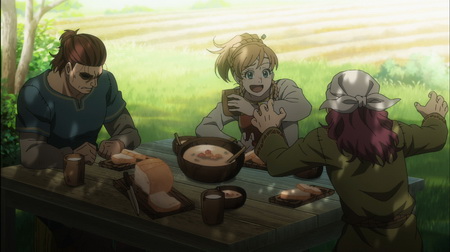 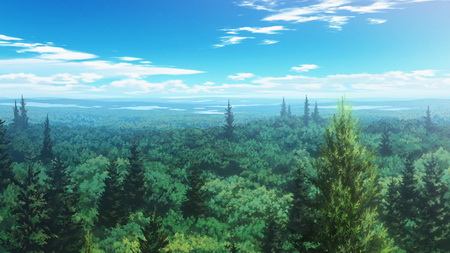 One thing Vinland Saga season 2 does NOT slowly roll out is its other main lead this season; Einar. He is a reddish/brown-haired young man who was loaded onto a ship making its way to the slave markets in Denmark. His past is explored a bit more later, but the new show thematic is quickly introduced and merged with the main thread in season 1: the violence and murder. Einar gets an immediate clue on how little his life is worth when the ship crew tosses a diseased woman right into the ocean lest she infect the others, to the horrified shock of the others. Einar is a temperamental young man, but Vinland Saga clearly shows us he fully understands the position that he's in. Even if that understanding will be tested many times this season. Once they arrive in Denmark, Einar is quickly sold to Ketil, the owner of a rather large farm complex near the coast. And at first he seem a pretty cool dude for a, well, slave owner. He works alongside his slaves, and he treats them with kindness for the most part. Even Thorfinn approves of him rather quickly, though Einar is more hesistant of course. You can probably guess this initially nice first impression will not last, as Ketil's true colors will show more and more as the season goes on. He's a real piece of work, he is. Ketil has two sons that are near polar opposites of one another. The younger one is Olmar, a whiny, pompous brat with an obnoxious Yakuza-style attitude that finds farm work beneath him and would rather seek glory on the battlefield. He seems to at least have a girlfriend who loves him (and whose feelings he does reciprocate, at least to the point that he never aims his childish reactions in her direction, which is more than you can say for the other men's attitude towards women). Olmar does gain more humility as the season goes on, but he gives a rather sour first impression. The older, more serious son is named Thorgil. Imagine a much less goofy, tanned, ruder Thorkell with a somehow even bigger perchant for violence, and you got your man. He has served in the King's guard, and has become terrifyingly good at his job. While Thorkell would (probably) never just outright murder people weaker than him, Thorgil relishes in dishing out violence regardless of who gets to suffer from it. To him it's what he lives for. Yeah, just because season two of Vinland Saga takes place almost entirely on a farm does not mean the show slacks off on the violence this go-round. While the overall ratio isn't as frequent as season one, when it is there it is much more visceral than before. Prepare to see people sliced in half, including their opened up heads, and lots of limbs chopped off. Lots and lots of limbs chopped off. And unlike last season, where at least some of the violence was "justified" since the people Askeladd and the rest fought were in a "do or die" situation, here a lot of tbe violence is dished out on slaves who can't/won't fight back, lest they face a death sentence anyway. Season two might use the rod more sparingly, but adds some nails to the rod to make up for it. Prepare to squirm, is what we're saying. Probably the most radical change between seasons - other than the scenery and violence - is Thorfinn himself. In season one he was constantly pissy, ready to fight Askeladd at the drop of a hat, killing others by his command with no hesitation. He was unkmept, rude, selfish, violent, and despite his sympathetic backstory, was a hard protagonist to root for at times. As Askeladd laid dying at the end of last season, he asked Thorfinn what he was going to do with his life even if he had gotten the revenge he had sacrificed so much of his humanity to obtain. And season two answers that with...a man who had turned into an emotionless drone. Without that drive, Thorfinn's a mere shell of a man, now the polar opposite of what he used to be: quiet, obedient, and even non-violent. He is ALSO in constant inner torment, now that his brain has cleared enough of the fog to make him realize the many horrible atrocities he had done as a Viking, including the insanely high kill count he has accumulated. The nightmares plague him every night, as he awakes screaming most of the time over it. And it's played very straight, especially when you learn about said nightmares. In a sense, it is a stroke of luck that Thorfinn is paired up with Einar. Our resident Englishman is already an adept farmer, so the two take to their task with an impressive gusto, enduring the many setbacks of slave farm work, manmade or not. And it's to Yukimura's credit that he manages to strike up a friendship between a man who had his life ruined by viking raiders, and one who used to be one. (Even if Einar came terrifyingly close to strangling Thorfinn in his sleep once Thorfinn told him about his past.) Einar himself develops a bit of a crush on one of the other slaves on the farm, a woman named Arnheid. While she does work on the farm much like the others, she's also Ketil's more or less concubine, meaning she sometimes shares his bed, with all the subtext that implies. Like Einar, Arnheid found herself at the losing end of a Viking battle, resulting in her son being killed and her husband also being sold off to a completely different farm. Like Thorfinn, the experience has also left a hollow shell of the woman she used to be, doing what she needs to to survive. She is treated kindly by Ketil, plus a small handful of other people (mainly slaves), but Vinland Saga still pulls absolutely no punches in its dehumanizing of slaves through a lot of the other residents of the farm. She's also later revealed to be pregnant, though not visibly so yet. In addition to the family, there's also a group of mercenaries working as farm guards. They are, like most other warriors in this show, Vikings, and with that comes all the less admirable parts of it. They mostly stay in their camp, eating, drinking (emphasis on the latter), and getting into fistfights for fun. The more prominent among the group all have nicknames - Snake, Fox, Spider - and form the core group that looks after Olmar whenever he's having one of his childish tantrums. Fox in particular gives him (and us by association) one of the better insights in how and why the warriors do what they do. And therein lies the barrier between people who have taken lives and those who haven't; once you cross it, you have to live with the knowledge you robbed someone of the experience of a full life. It very nearly completely destroyed Thorfinn, but Fox and his fellow Vikings don't seem that upset by it in comparison. Instead they angle (other's) deaths like a product they're selling, based on the fear and unwillingness of their victims. They do have an unspoken system that puts a value on each head; the better you are at fighting, the higher that value. As you might expect, this puts slaves right down there at the bottom. They're not people. They're assets, to be used to make whatever point you want to make. (And Einar has a rather short fuse with their behavior on this.) So when Fox and co. task Olmar with killing someone to "become a man" (as they put it), it becomes a problem for them when their chosen victim, Thorfinn, doesn't even seem to care; he even seems to welcome said death. (Even chopping off a piece of his ear - and yes it stays that way the rest of the series - doesn't faze him.) See, they're selling the fear of death, not the actual death. It is Snake who actually instills into Thorfinn the fact that he might actually want to live. Snake seems to be considered the leader of this motley band, but until he delivers that one kick, you might not think much of him. He spends most of his time at the house of Sverkel (Ketil's father) eating and sleeping, much to the latter's consternation. He is at least partially tasked with keeping an eye on Sverkel (on Ketil's behest), as Sverkel is an old man, very likely to throw out his back from his work. Snake does at least seem unwilling to fight despite his very strong combat skills, and it takes quite a lot to make him lose his temper. The last major character of note is Sverkel himself. While he comes off at first as the cranky old man archetype, he's actually one of the overall nicer people on the farm despite his angry scowl and rough voice. He lets Thorfinn and Einar use his valuable farm equipment - and even borrow his horse - in exchange for chores. He also gets brownie points for us because he, too, finds his son Ketil to be a crappy person. He DOES love his son, but he's also more than happy to have him learn from his mistakes, and to try to be a better person through looking after his slaves, treating them more like humam beings rather than a job opportunity. While you could make an argument that Ketil is treating his slaves well, that still doesn't change the fact that he's economically supporting a group who had absolutely no problem abducting Einar from his home after killing his family (and also wanted to rape his teenage sister). All this is counter to Thorfinn himself, who is really starting to understand how evil he was becoming in season 1. 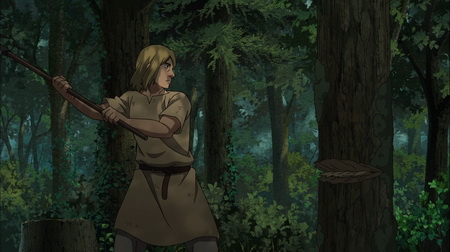 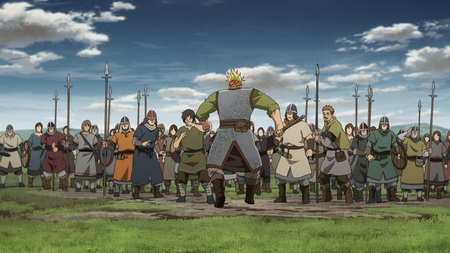 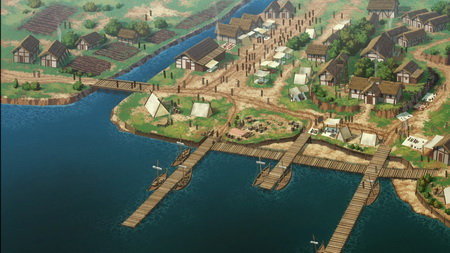 Tim: Earlier in the review I noted how season one of Vinland Saga could work as a self-contained season, and I still stand by it. Which is why you might be reading this review and notice we haven't talked about any other characters from season one aside from Thorfinn so far. And that's because they're just not here. Aside from Prince Canute, Floki, and a glorified cameo from Thorkell, pretty much no other season one characters appear in season two until nearly the end of the season. It's to the point where two characters who are dead have more appearances in certain characters' thoughts than they some of the living cast members do. It's a season of new beginnings. And unlike, say, Frieren: Beyond Journey's End, which introduces a dozen new characters two-thirds into a season and expects you to just care about/like them, Vinland Saga Season 2's cast is spread out more organically and slower over time. I never felt overwhelmed having to remember so many characters, since the series does a good job slow burning them into the show. And with the possible exception of Olmar and a later slave character I can't talk about due to spoilers, Vinland Saga is still devoid of the "comic relief" archetype. (And even then, most of Olmar's humor derives from people laughing at him.) There's plenty of humor - both dark and light-hearted - to go around without the need for a character to just be there with a sign reading "laugh at me". Stig: Vinland Saga tends to sort its characters into cliques, each group having kind of a de-facto lead character. Canute is now basically the King of his men, while Snake is the leader of his own small group of mercenaries. Ketil and his family also follow a typical group structure with him and his sons being the top dogs. And then there's the lowest rung; the slaves. Those are people who have been torn from their own groups and put in new ones, at the mercy of whoever now owns them. Needless to say, neither of the slaves wants to be where they are. And Olmar, whom Tim mentioned above, is probably the only non-slave who wants to switch groups, and through the aforementioned humor, is the one who really doesn't realize what he's trying to sign up for. Vinland Saga is the anime variant of the videogame Spec Ops: the Line, in the sense that you are (almost) being led into a trap. Characters like Askeladd and Canute (or even Thorfinn once he got his revenge groove on) are often looked upon as heroes by the viewing community at large. Askeladd also happened to be a very charismatic man, which gave him a lot of leeway through his definintely lesser admirable moments (of which there were many). You could argue that all his actions were for the sake of protecting his home from the invasion of Canute's father, Sweyn Forkbeard, but you'd have to be pretty blasé about people you have no personal connection to if you aren't going to think Askeladd isn't a complete bastard himself. Not that Vinland Saga ever dared anyone to think well of the people who caused so much death and destruction in the aforementioned season, but according to the grapewine, there were complaints about the second season not offering as much action spectacle as the first one did. It's just such a spectacular way to completely miss the point of what the original manga this show was based on was trying to make. Aside from Thorfinn, the person who changed the most between seasons - though in a slightly different direction than Thorfinn - is King Canute. In season one we first met him being transported (evacuated) from his father's plan to have him killed in battle. This was done mainly because Canute was a long haired, quiet, shy blond taken care of by his retainer, Ragnar, rather than the beacon of manhood his father preferred as the inheritor for the throne. Canute had an innocence that Askeladd literally - and intentionally - killed with the death of Ragnar. Canute slowly changed over time, going from a crybaby to a stone cold, straight faced, short haired, bearded young king. He even went so far as to poison his own brother to control more land for the sake of his future and that of his men...and now he plans to take Ketil's land by way of trickery and deceit. It's almost kind of scary how Canute has changed in only a few short years. If this were a more traditional fantasy anime series, he'd be a legitimate villain. Earlier in this rundown, we talked about how two dead characters get more screentime than some of the living cast members of season one. And that's because in season two of Vinland Saga Thorfinn and Canute are haunted respectively by Askeladd and the former King Sweyn. Askeladd meets Thorfinn in one of his most intense nightmares in Valhalla, which in Vinland Saga is represented by an arena of Vikings just mercilessly beating each other up, with Thorfinn wondering what this place even is. It would probably be more true to call the pile of dead bodies rising up and grabbing Thorfinn to be the part that's haunting him specifically, though, because those are the people whose deaths can be attributed to him, whether directly or indirectly. This afterlife is a terrifying concept, since you seem to end up there whether you fell in battle or were just murdered wholesale before even knowing what was coming, visually coming across more as a hell that continues even after its victims are dead from a situation they wanted no part in to begin with. Canute, meanwhile, is haunted in his daily life by the decapitated head of his father. At first the image of his eyeless, rotting head is creepy, but as the series goes on, it goes from scary to unintentionally hilarious. After a while it just seems like the former King is just messing with Canute for fun (even though it is all in Canute's head to begin with). In the end, despite the huge supporting cast, this is still Thorfinn's journey. Vinland Saga is still so far away, and Thorfinn has to carry more people than ever now. 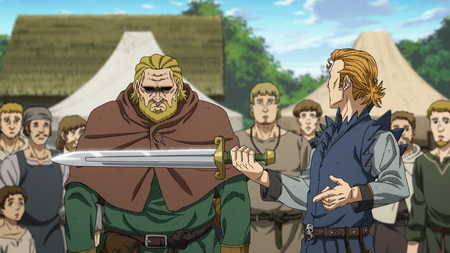 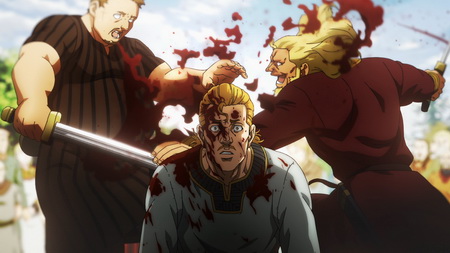 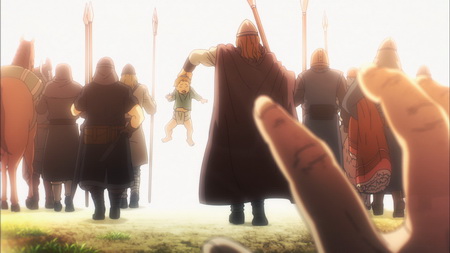 Stig: Once again, I have to nod my head in appreciation of the sheer scope of this story, never mind the research that had to have gone into it. Sure, the story might have been entirely fictional at this point save a few key points, but that doesn't make it any less historically real on a more general level. Tim: I'll just sum it up with one simple question; "When is season three?" Hopefully not five years from now. Vinland Saga remains as strong an entry as ever. Find yourself a really comfortable chair, because the show is going to be decidedly uncomfortable. And you're going to love every second of it. — Stig Høgset and Tim Jones Recommended Audience: The moments of violence, while not as frequent as in season 1, are more visceral than ever. Being visited by the Vikings were very rarely a sign of good fortune for anyone, and the machinations going on behind the veil does not spell good tidings for whoever were caught up in the struggle. That is a lesson the anime has made damn sure nobody would miss the point of, and for those who have read ahead in the manga, will not stop there. Version(s) Viewed: crunchyroll.com stream, English dub (Stig), HIDIVE stream, Japanese with English subtitles (Tim) Review Status: Full (24/24) Vinland Saga (Season 2) © 2023 Makoto Yukimura / Kodansha / Vinland Saga Production Committee |
 |
|
| © 1996-2015 THEM Anime Reviews. All rights reserved. |